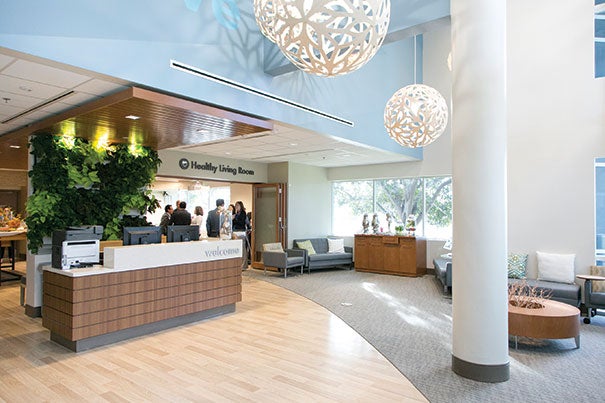Kaiser Permanente opens first of community health hubs

Kaiser's newest concept advances the move toward population health.
Kaiser Permanente, Oakland, Calif., has opened the first of several new medical centers it will build in Southern California that could take patient care and overall experience to a higher level.
Kaiser Permanente plans to raise the traditional medical office building bar several notches with facilities designed to become an attractive destination that promotes health education and activities. The health system’s new 8,000-square-foot clinic in Manhattan Beach in Los Angeles County is the first to open as construction continues or starts on nine other sites. HDR Inc. designed the first of the facilities.
The new facility offers a warm and welcoming design that starts with a waiting room featuring natural light, wood furnishings and live plants. To make the experience more efficient, patients have the option of checking in by either using a kiosk or seeing the service representative. A text message alerts patients when their doctors are ready to see them, giving them freedom to move about until that time.
The exam room extends the patient-centric experience through its design and furnishings that emphasize comfort and ease of communication with the doctor. The room will include an electronic monitor, allowing the patient to see what the doctor is writing in his chart. The physician also can use the monitor to set up an on-demand consultation with a Kaiser Permanente specialist if necessary.
Technology enables patients to schedule live interactive video visits, receive educational content for online viewing at their leisure, and order medication at the site’s pharmacy from the exam room rather than waiting in line to drop off a prescription. Clinicians are provided with mobile devices for efficient communication.
Plans call for the larger clinics — up to 105,000 square feet — to offer on-site wellness and health education programs on such topics as exercise and nutrition as well as yoga and cooking classes.
Jodie Lesh, senior vice president of strategic planning and new ventures, Kaiser Permanente Southern California, says the health hubs are meant to serve as community anchors that focus on healthful living and wellness and not just treatment.
“These facilities are very different on a lot of levels,” she says. “First of all our brand is unique, which is about the promotion of health and wellness and keeping people healthy. The health hubs are an expression of that philosophy.”
Instead of heading home after their appointments, Kaiser Permanente hopes patients will linger in and around the clinics and take advantage of the educational programs and activities. For example, one health hub will feature a two-mile walking path, which the community presently lacks, and all will have public squares where community events can be held, Lesh says.
The plan for the new clinics began about three years ago when Kaiser Permanente began to explore how to reimagine ambulatory design along with the future of care delivery, Lesh says. The result is the health hubs and their community focus.
“The conclusion of the discussions was that health care needs to be woven into people’s lives much more meaningfully than it is today,” Lesh adds. “We needed to meet people where they are living and not just have them make an appointment and come to us.”
Each facility will be staffed by Southern California Permanente Medical Group physicians who will be supported by registered nurses, licensed vocational nurses and medical assistants. Some sites will include specialists such as pharmacists, radiology technicians and more depending on the services offered.
The health hubs are designed for flexibility to increase capacity in the future if needed. All of the new facilities are projected to open by the end of 2017, according to Kaiser Permanente.




